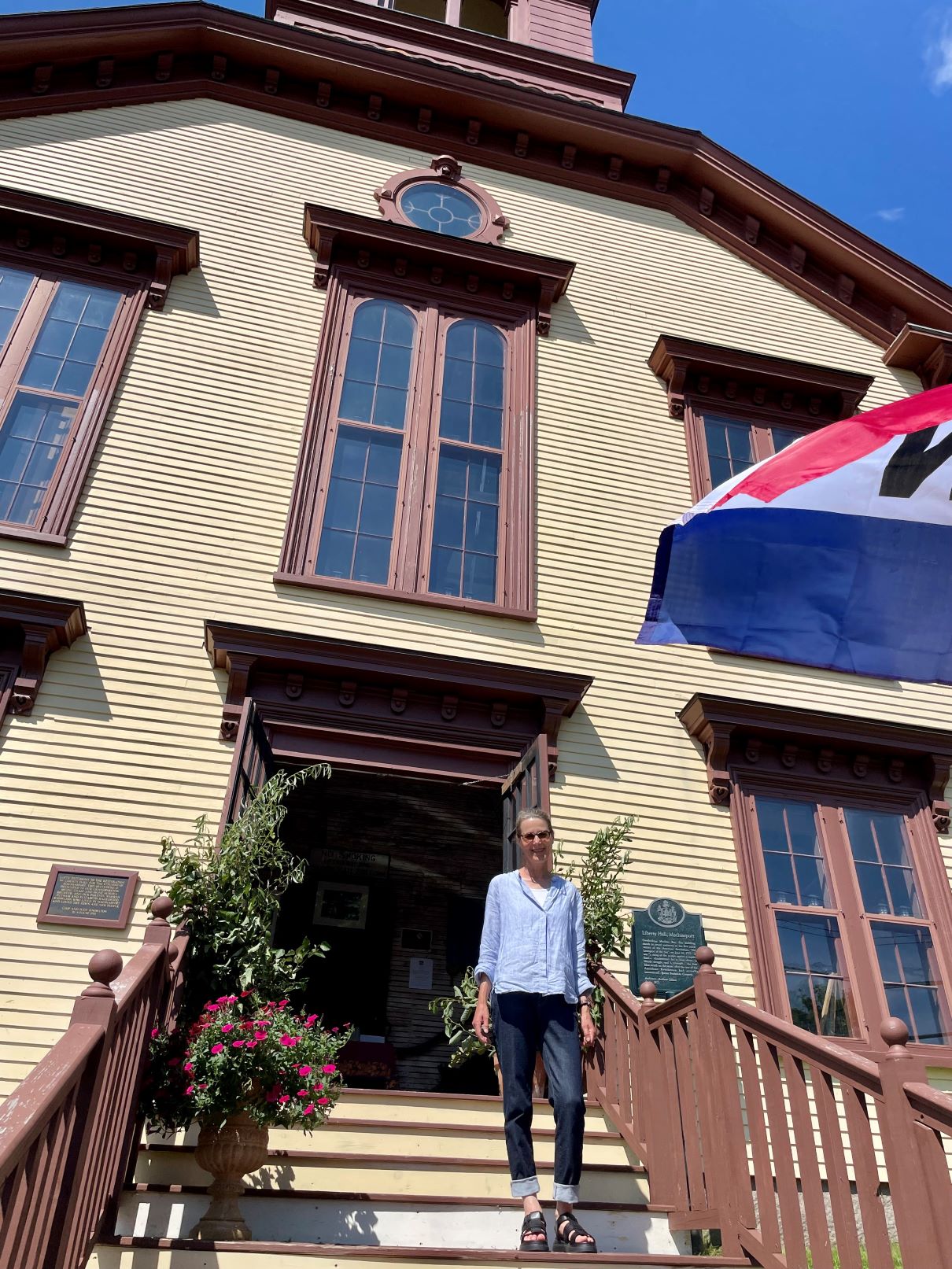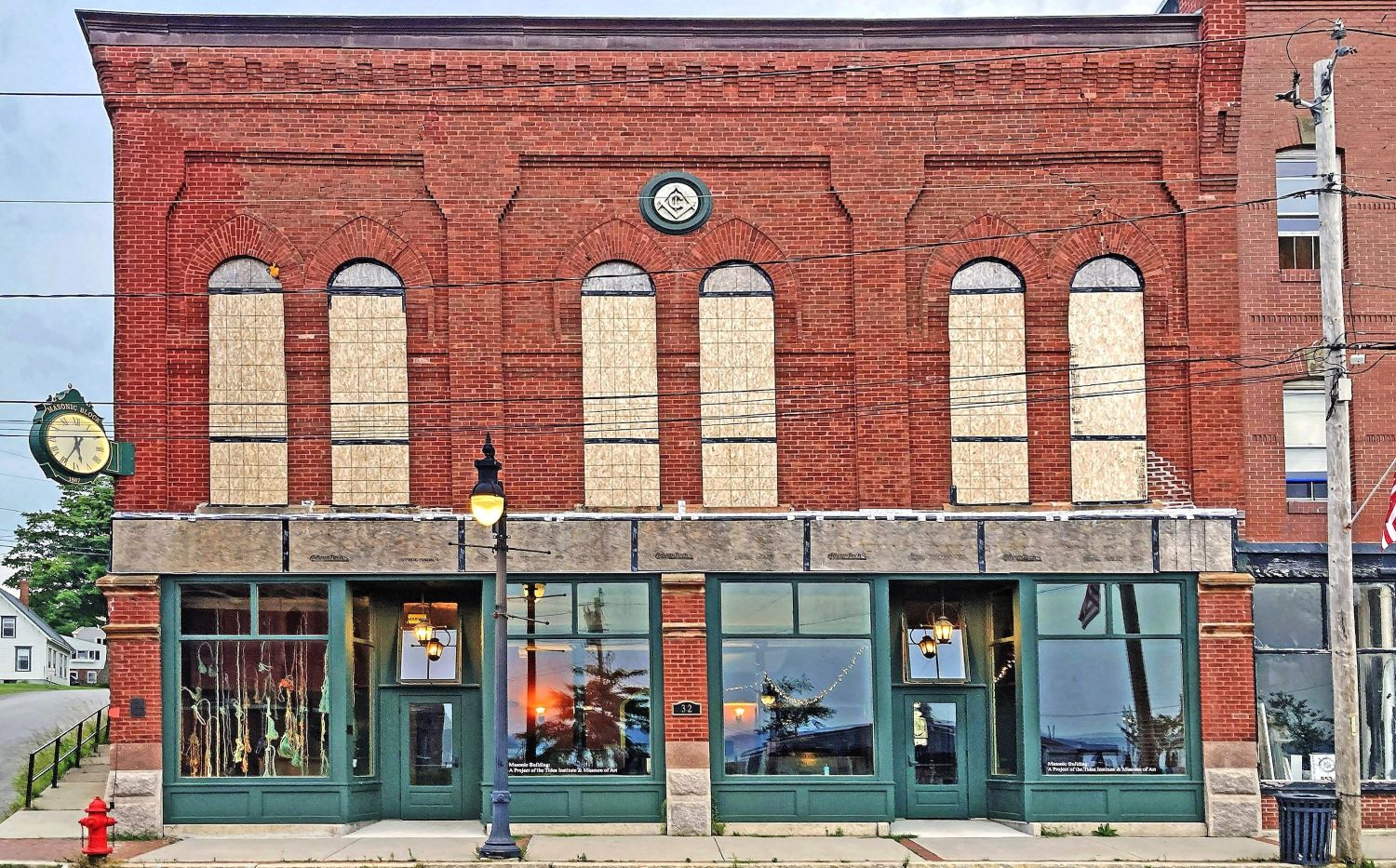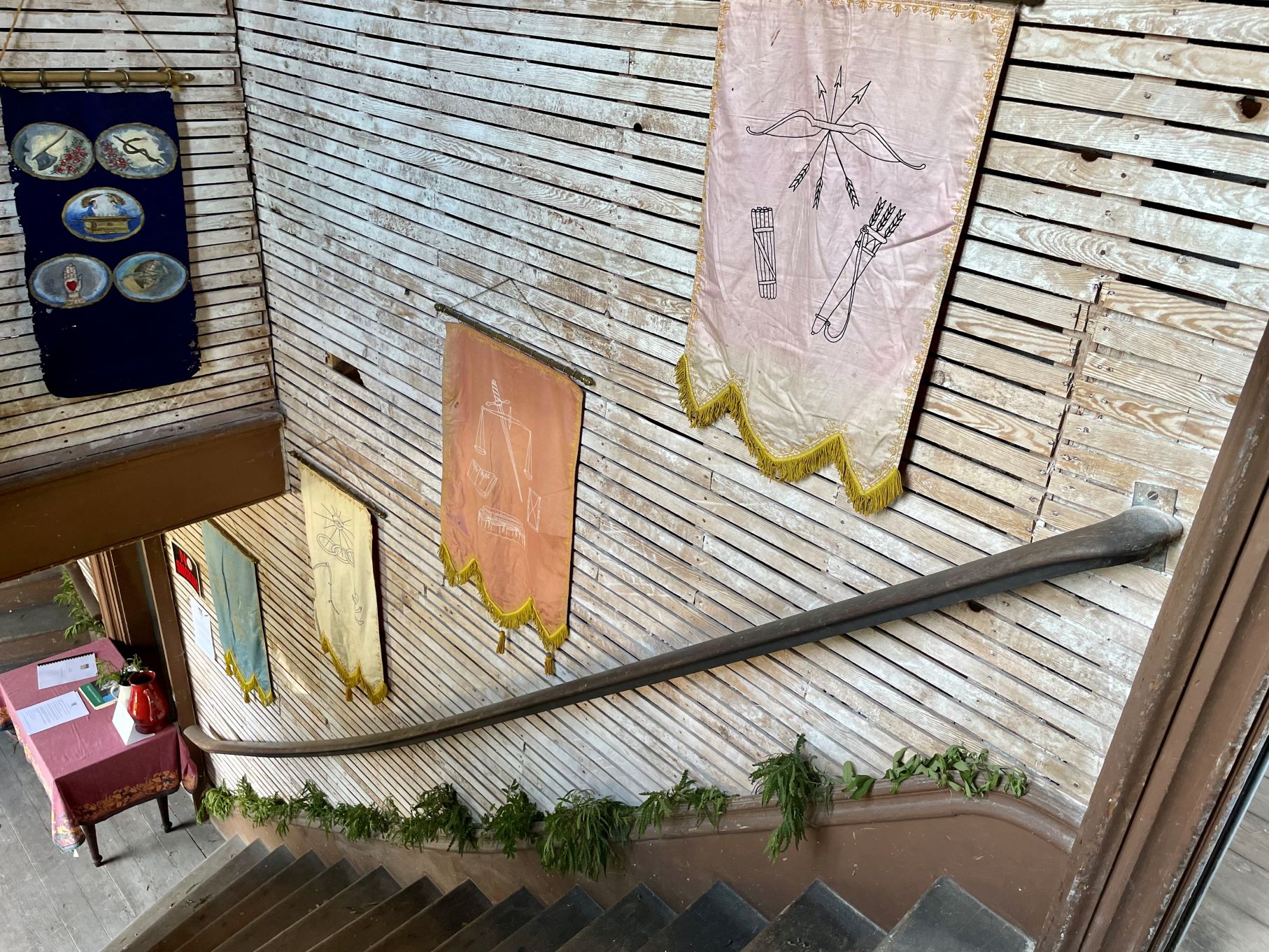Standing sentry in Machiasport near the site of the first Revolutionary War naval battle, Liberty Hall with its stately façade tells the story of a time when civic halls and granges were the heart of rural communities.
Liberty Hall drew more than 400 people dancing until dawn when it opened on a blustery January day in 1874. Now, only echoes remain of the revelers and a bustling wharf that birthed a prosperity that led to the need for such a grandiose gathering place.
Today, fewer than a dozen people make up the Friends of Liberty Hall, a team of local supporters working since 2006 to preserve and renovate the time-ravaged, two-story Italianate building with its iconic belvedere cupola.
“It’s been long and often discouraging,” committee secretary Anna Grimshaw said. “You kind of make it up as you go along because there’s nobody to help, to say ‘this was our experience.’ ”
But Liberty Hall isn’t the only derelict 19th-century civic hall fighting for survival.
Hoping to document the historic structures and spur wider interest in saving them, the Friends of Liberty Hall — in partnership with two nonprofits, Greenhorns and Maine Preservation — researched Downeast civic halls, then circulated a survey to any civic hall caretakers who could be traced.
The new study unveiled last week at a Liberty Hall open house found that Washington and Hancock counties alone had at least 124 civic halls, granges and other fraternal organization buildings. Ten already have been lost to fire or demolition, five others are in immediate peril, and many others report being in serious disrepair.
Of the 67 surveys sent out, 25 were returned with answers to exhaustive questions ranging from past and current use to details of the buildings’ condition and plans — if any — for preservation.
“The idea is to have a complete data set to understand all the obstacles and challenges, and then for us to be able to provide solutions … to create toolkits around these processes to access funding,” said Tara Kelly, executive director of Maine Preservation, a statewide, nonprofit historic preservation organization.

Starting alone with nothing more than determination, a trickle of donations — and countless grant applications — Grimshaw said the Friends of Liberty Hall managed to scrape together more than a half-million dollars in public and private funding to stabilize the façade and begin its return to grandeur.
The committee needs to raise that much again to restore the interior, eventually reclaiming the town-owned hall for use by Machiasport citizens as a civic space for community meetings and events.
The Liberty Hall project first came on the radar of Sen. Angus King, I-Maine, last year.
Although the project did not get the $1.5 million of the Senator’s federal earmark funding requested in the last cycle, supporters are mounting another effort. The Senator’s regional representative, Edie Smith, attended the Liberty Hall open house and following the event told The Maine Monitor that Liberty Hall’s designation on the National Registry of Historic Places, as well as an early application, helps chances for earmarks in the upcoming round.
“It’s a very bulky competitive process, but definitely the earmarks are available,” Smith said.
Other civic hall caretakers report facing daunting challenges of their own while trying to stabilize and maintain their historic buildings.
Two halls reported by the survey to be most at risk are the Schoodic Grange in Franklin and the American Legion in Jonesport, both faltering due to unclear ownership and lack of guidance.
Still others have been converted to commercial properties or residences, with halls in Weston and Lubec up for sale, according to Greenhorns founder Severine von Tscharner Fleming and Nadine Biss, a Maine Preservation and Greenhorns intern who helped with the research and prepared the survey results.
Although survey responses varied widely regarding affiliations and current status, the structures share one bond: All were built during the “Golden Age of Fraternalism” from the mid-1800’s to the mid 1900’s, when roughly 70,000 fraternal orders sprang up nationally after the Civil War.
Some like Liberty Hall were municipally owned, but most were created by dozens of national and international fraternal and volunteer associations during a time Americans became a Nation of Joiners, coined in a 1944 article by historian Arthur M. Schlesinger.
“Considering the central importance of the voluntary organization in American history there is no doubt it has provided the people with their greatest school of self-government … rubbing minds as well as elbows,” wrote Schlesinger.
A few of the most notable organizations that are still familiar today include the Patrons of Husbandry (the Grange); the Ancient, Free and Accepted Masons; the Benevolent and Protective order of Elks; and the International Order of Odd Fellows. These groups and many others rallied around their self-appointed political, moral, humanitarian or civil causes.
One of the most successful was the Grange, which supports rural communities and farmers. Through national and local efforts, the Grange was a catalyst for rural mail delivery. The organization was also at the forefront of equal rights, encouraging women to serve as officers.
According to the Maine State Grange website, the number of granges in the state grew from 64 in 1873 to 419 by 1907, with membership soaring to more than 55,000. Granges appealed to rural Mainers in particular, offering insurance, advocating railroad and banking regulation, and promoting group purchasing. By the turn of the century, Maine’s per capita Grange membership was the country’s largest.
“The decline of farming and other demographic and cultural changes began to affect membership levels of the Grange after 1960. While the Order is still a factor in many towns through its community service role, and its halls are one of the icons of the state’s landscape, the number of Granges has dropped to about 180 and membership is now approximately 8,000. Many efforts are being made to revive interest in the Grange, and encourage membership development with enhanced programming and membership benefits as incentives.” wrote State Historian Stan Howe.

Among the Downeast civic halls identified through the study, 51 continue as fraternal or voluntary associations, such as the Halcyon Grange in Blue Hill, one of only nine granges still active Downeast. In Lamoine, after serving for years merely as landlord to other groups, the Grange in that town returned to its roots, signing up a new generation of devoted Grangers.
Threatened with dissolution due to low membership, the Lamoine Community Arts organization joined the Grange to keep it operational, with artists even participating in the fraternities’ hallowed rituals, according to the survey.
Stewards of the 48 other surviving civic halls are also finding creative new ways to keep a roof overhead and the doors open.
Reversing Hall in Pembroke is one of them. The former Odd Fellows Lodge is now owned and operated by Fleming under the nonprofit umbrella Greenhorns, an agricultural and aquatic cooperative that is a partner in the survey project.
Housed on the first floor of Reversing Hall is a library, study room and kitchen, with events and workshops offered on the second floor. Abandoned by the Odd Fellows in 2006, the building was once on Maine Preservation’s most endangered list before Greenhorns rescued it in 2018.
“Cherishing and preserving these buildings is a great way for us to all get to know each other and to work together with dignity,” Fleming said. “In fact, keeping these spaces alive requires us to work together.”
Fleming brought some of the iconography and regalia she resurrected from the Odd Fellows Lodge to festoon Liberty Hall’s grand two-story meeting room for the event last week. About two dozen supporters, neighbors, and curious tourists gathered to hear a panel of speakers make the case for a unified approach to saving Downeast’s civic halls.
Joining Fleming and Kelly as panelists were Molly Cashwell, executive director of the Maine Cultural Alliance; Martha Piscuskus, program director for the Maine Arts Commission, and Crystal Hitchings, director of promotion programs for the Sunrise Council Economic Council, serving Washington and Hancock counties.
Hitchings said revitalizing the region’s civic halls could also help revitalize the economy because Downeast Maine has an important character story to tell through its unique heritage.
“These were important spaces for our people to come together and build a community that we still value today and that helped us remain strong through all the changes,” said Hitchings, who also manages the new Downeast Maine Natural Heritage Area.
King was one of the main sponsors of the federal Downeast National Heritage designation.
Smith, King’s representative, said it’s another recognition of how special the area is, a designation she said can lift everyone as things progress.
“It also helps organizations that are applying for grants,” Smith said. “They can say we’re in an area that is a National Heritage Area recognized by the federal government, and that carries some weight.”
Nowhere have they more deeply embraced — and leveraged — heritage than in Eastport, a once-thriving shipping and passenger port at the far eastern edge of Washington County.
Eastport, like other Downeast communities, has struggled to ride the tumultuous tides of the evaporating fisheries industry. In the midst of its revival as an arts center, city leaders recognize how crucial historic buildings, and the stories they house, are to the city’s rebirth.
Under the ownership and direction of the Tides Institute and Museum of Art (TIMA), the monumental restoration of the former Masonic Lodge on Water Street is being reimagined for exhibit and archive space, working artist studios, and eventually a restaurant on the first main floor. Once complete, the former Masonic Lodge will be the touchstone of the downtown Eastport, (Muselenk), Maine National Register Historic District.

The three-story, imposing brick structure built in 1887 by New Brunswick architect Henry N. Black, was abandoned by the Masons in 1982. Over 35 years of neglect, the Lodge deteriorated until TIMA stepped in to save it from imminent collapse.
The group’s director, Hugh French, said the importance of the project was recognized by the National Endowment for the Humanities, which recently awarded TIMA a $400,000 challenge grant for the next phase of the multiyear restoration project. It was the first grant of its kind ever awarded in Washington County.
In the TIMA Rising Tides YouTube video detailing the restoration, it becomes clear how painstaking the restoration is as a master stone mason, Danny Thaxter, points to an intricately numbered schematic for replacing the building’s six towering arched windows. Each window requires about 96 precision cut bricks.
“We are rebuilding the cultural fabric of this area, piece by piece,” French said. “We do what we say we’re going to do in an area where doing (so) is vitally important.”







